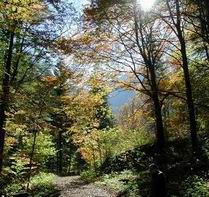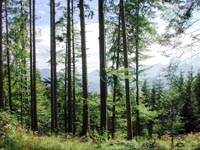"The primary function of REDD+ is to realize green house gas emission reductions from forest ecosystems to avoid the worst effects of climate change. Apart from this substantial carbon sequestration and storage function, forest ecosystems harbor many important development benefits or ‘safeguards’ against disasters. These services underpin human well being, especially for those most vulnerable and for 1.6 billion forest dependent people, by providing fuelwood, timber, shelter, non-timber forest products such as fruits, medicines, gums, mushrooms as well as recreation and cultural services."
So far the rationale taken from the UN-REDD webpage report called "Safeguarding Multiple Benefits" written by Wahida Patwa-Shah and Linda Rosengren.
| ⇒ |
Being enthusiastic and optimistic on your own programmes is quite ok, however the first sentence should read more objective like this: Just to be mentioned. |
When reading these first lines of the article you might ask yourself “are we currently witnessing the long expected quantum leap in how international organizations like the UN are seizing services provided by forests?” Of course the lines are missing protection against natural hazards – but this just might be a slip of the pen.
Mentioning fuelwood, timber and shelter at imminent position sounds very promising. The skilled reader of all those articles targeting deforestation or reducing emission from forest degradation is normally conditioned on terms like biodiversity, carbon sequestration and social aspects. But there is more mentioned: recreation and cultural. Yes, yes, yes! The thrill is rising…
“These benefits may be for example, high carbon densities occurring in biodiversity-rich natural forests and rehabilitation of degraded forests with indigenous trees to improve watershed services.”
|
|
Some buzzwords like “stakeholder participation ... risk of reversal and displacement and knowledge and rights of indigenous peoples and local communities ...”
OK, this is put down because the author has to meet the expectations of a certain clientele. Read on – hurry.
Come on – tell us something about timber, fuelwood, natural hazard protection…
"...identifying where high biodiversity and high carbon overlap in order to allow informed decisions to be made on the biodiversity benefits of prioritizing different areas for REDD+. In this manner, biodiversity protection is included in REDD+ with only a relatively small additional cost."
Hmm.
“The UN-REDD Programme is supporting countries as they seek to take into account the real costs of alternative uses of forests, adequately addressing who bears the costs of present or future changes in uses. These efforts focus on ensuring that the poor are not affected negatively as a result.”
Bums, the tire is flat.
“Alternative uses of forests … costs of present or future changes … the poor are not affected negatively…”.
Forest uses like timber and fuelwood are not mentioned any more. Instead the authors are talking about “alternative uses of forests” and “costs of changes”.
We ask ourselves the question why the use of wood as one of the essential functions of forests is allowed to be mentioned only in whispers?
On the other hand this creates the impression that only the use of non timber forest products is legitimized.
REDD+ is the result of long-winded negotiations. It has undergone a long succession starting with RED, growing to REDD and finally ending up with REDD+. So firstly only deforestation was seen as the battlefield then people realized degradation of forests could be a threat as well. The PLUS-part of REDD is the youngest achievement and stands for conservation, sustainable forest management and enhancement of forest stocks.
Combining the reduction of deforestation and degradation with conservation and sustainable forest management makes perfect sense and is definitely the way mankind should walk. In which we see the enhancement of forest stocks as an integrated part of sustainable forest management.
Finally we do have two options: conservation and sustainable forest management.
Conservation seems to be a simple task. “Don’t touch” – “keep away” – is things people learned in early childhood. Understanding this is well trained and well known to everybody. And people are used to simplify life. The KISS concept (keep it simple and stupid) is therefore perfect for REDD. Many people therefore equalize REDD+ with forest conservation.
However the promising title of the UN-REDD article was very much appreciated. At least there is people who start to think about the second option of REDD+: Sustainable Forest Management.
|
|
But the disappointment was big when perusing the text. The authors failed to explain sustainable forest management. They contributed to the zeitgeist placed all those buzzwords which are have to be in a REDD+ text and carefully omitted to address wood utilization and sustainable forest management.
This is symptomatic for a lot of REDD+ articles – the most of the authors love to praise ecosystem services and non-timber forest products but talking about the utilization of wood and sustainable forest management is a big no-no.
I do have my own views on this topic and why this happens. I think all these people avoid talking or writing about sustainable forest management (SFM) because they do not have any idea about it.
For them, sustainable forest management seems to be just like science fiction. They see it is a little bit of objectionable (because cutting of trees and utilizing of wood is a substantial part of it), there is some fascinating facet’s (taming the strange, wild beast) and there is no evidence of successful implementation (the fiction part). Oh yes, there is one more: currently nobody was able to exactly define what it stands for. There are just rumors.
But wait! It’s not all lost!
There is sound knowledge in sustainable forest management. Even better. In some countries foresters are successfully operating sustainable forest management since decades. And yes, these foresters are utilizing wood (so they cut trees), are keeping biodiversity rates at highest levels, they sustain ecosystem services like highest quality drinking water and protection against natural hazards and they key the landscape attractive for millions of tourists.
All this is done by sustainable forest management teamed with well-considered conservation strategies. Forest income is realized by selling of wood, public compensation for any kind ecosystem services and direct payments throughout tourism.
So, sustainable forest management is not science fiction it is reality and can be studied and watched when visiting central Europe (Austria, Germany and Switzerland). All those who would not believe – just give me a call when visiting Austria, I am prepared to demonstrate our sustainable forest management.
The international year of forests seems to see the things a bit clearer...
---------------
June 2010: Wood still no option for UN-REDD...



